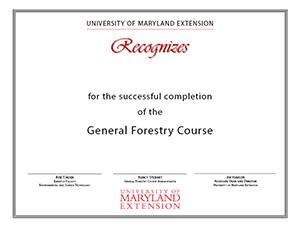Introduction
This course is designed for individuals wishing to increase their understanding of forests and forest management. Specifically, the course targets Maryland forest landowners and other citizens with an interest in the principles and practices of forestry. There are no prerequisites; however, owning or having access to a forest is necessary to complete the framework of the required forest stewardship plan.
The course is divided into six units, with each unit containing several lessons, with a multi-question quiz at the end of each. There are also assignments following most lessons. Resource information is located in the appendices.
Note: The General Forestry Course will be offered for August 25 - December 8, 2025. Registration through Eventbrite will open in early July.
Enrollment is on a first-come, first-served basis. The course will begin on August 25 and run to December 8.
Course Contents
Unit 1 - The Forested Landscape
offers an overview of worldwide forest resources, Maryland's forests, a brief history of forestry, and a description of the governmental agencies that regulate and manage forests.
Lesson 1. Introduction
Lesson 2. The World's Forests
Lesson 3. America's Forests
Lesson 4. Maryland's Forests
Lesson 5. History and Policy
Lesson 6. Key Players
Unit 2 - The Forest and the Trees
covers basic tree physiology, tree identification, forest ecology, and the distribution of the various types of forest cover.
Lesson 7. Tree Identification
Lesson 8. The Tree and How It Grows
Lesson 9. The Forest Community
Lesson 10. Natural Cycles in Our Environment
Unit 3 - Forest Care
discusses the art and science of silviculture, forest health, and protection of the forest from insects, disease, and fire.
Lesson 11. Silviculture - The Art and Science of Forestry
Lesson 12. Forest Health
Lesson 13. Fire and Forest Protection
Unit 4 - Forest Inventory and Analysis
explains the process of conducting a forest inventory, a stand analysis, and interpreting the data.
Lesson 14. Inventory - An Introduction
Lesson 15. Planning the Inventory
Lesson 16. Forest Inventory - In the Field
Lesson 17. Interpreting the Data
Unit 5 - The Management Plan
highlights elements of a forest stewardship plan and the management choices available to the forest landowner. In the course of learning how to prepare a forest stewardship plan, students will develop the framework of a plan for their property.
Lesson 18. Elements of a Management Plan
Lesson 19. Managing Forests for Wildlife
Lesson 20. Managing for Forest Products
Lesson 21. Managing for Outdoor Recreation
Lesson 22. Managing for Aesthetic and Ecological Benefits
Unit 6 - The Business of Forestry
describes the business of forestry—the sale, the harvest, and the manufacture of forest products.
Lesson 23. Financial and Legal Considerations
Lesson 24. The Harvest
Lesson 25. Site Preparation
Lesson 26. The Manufacturing of Forest Products
Assignments:
Most lessons are followed by reading assignments, typically a chapter, a publication, or less than ten pages of reading. Several lessons require the reading of two or more publications.
There are five lessons which are followed with field assignments that take you into the forest. The field work requires that the student:
-
make a study collection requiring identification of tree species
-
make bark rubbings and collect leaf samples
-
use a recently cut tree to identify parts of the trunk and determine the tree's age
-
construct a Biltmore stick with the materials provided, and measure tree diameters and heights
-
determine vegetation in overstory and understory and succession stage
-
obtain soil survey and other maps or photos
Required Texts: (These are included with the course materials.)
A Sand County Almanac
by Aldo Leopold. 1966. New York: Ballantine Books. 295 pages.
American Forests: A History of Resiliency and Recovery
by Douglas W. MacCleery. 1992. Forest History Society, Durham, NC. 58 pages.
The Woodland Steward: A Practical Guide to the Management of Small Private Forests
by James R. Fazio. 1987. Moscow, ID: The Woodland Press. 2nd edition. 212 pages.

|

|

|
Still more!
Also included with the materials is a small tree identification brochure entitled What Tree Is That?

Participants will receive a USB flash drive with the original General Forestry Course text as well as the appendices. The Discussion Board posts and the interactive exercises will not be included.
Optional Text:
Essentials of Forestry Practice
by C.H. Stoddard and G.M. Stoddard. 1987. New York: John Wiley and Sons. 4th edition. 407 pages.
Course Requirements:
-
Read each lesson in the course text.
-
Complete the additional readings and assignments.
-
Answer the questions in the What Is Forestry? quiz at the start of the course and in the review quizzes found at the end of each lesson.
-
Develop and write the basic framework for a forest stewardship plan.
-
Participate in the group discussions posted on the discussion board.
Certificate of Completion:
Upon completing the course successfully, students will be awarded a certificate of completion.
